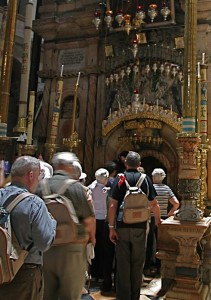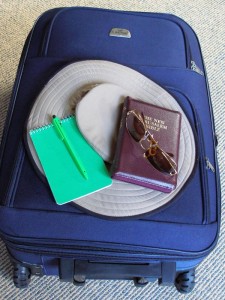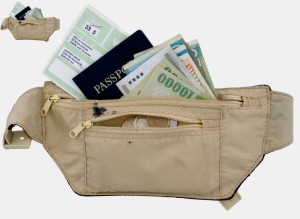Bags: Suitcase, cabin bag, day bag
Bags: Suitcase, cabin bag, day bag
1. Travel light. One suitcase of up to 20kg (to check in free) and one cabin bag of up to 7kg will satisfy most airlines’ requirements for economy passengers. Some travel companies supply pilgrims with appropriate cabin bags and day bags.
2. Don’t fill your bags. Leave room for items you may buy on the trip.
3. Don’t take more than you can comfortably carry or trundle on wheels. Travelling light also makes it easier to keep track of your luggage when it is being loaded on and off buses, and in and out of hotels.
• Suitcase: Clearly label your suitcase inside (name, home address, phone number and destination) and outside (name and destination). Remove old labels. Put a photocopy of your itinerary on top of your clothes.
Attach a sticker, ribbon or other identifier to your suitcase to make it easier to spot.
Do not pack anything expensive, such as a camera, in your suitcase.
Airline security regulations require that checked baggage be unlocked (unless you have approved locks that security personnel can unlock and relock).
• Cabin bag: Your carry-on bag should contain everything you will need on the way to your destination, such as essential medication or toiletries (but see below about liquids).
Include overnight necessities and a change of clothes (but no sharp items, not even nail files). Medically necessary injection needles require a doctor’s certificate. Be prepared for the possibility, however remote, of your checked-in suitcase getting “lost in transit” for a day or two.
• Day bag: A shoulder bag or backpack is extremely useful for a pilgrim. It can carry such items as your Bible (or New Testament), water bottle, any medication you need during the day, sunscreen, insect repellent, wet wipes, a small roll of toilet paper (travel rolls can be bought), hand sanitiser, a small torch, pen and notepad.
Clothing
A experienced travel writer has said: “Take the advice of one who knows — take twice as much money and half as much clothes.”
Light, loose-fitting, mix-and-match clothing is the pilgrim’s standby. Think convenience before fashion. Wear layers of clothing that can be shed or replaced at will (cardigans or stoles are handy). Even in summer, a jacket or sweater will be needed in the cool evenings.
Colour is also important. White clothes will not stay white long in the Middle East. Black will absorb the heat and cause discomfort. Light colours or mid-tones are best.
Sunhats are essential. Take a swimsuit for opportunities such as the Sea of Galilee, hotel pools or an unsinkable dip in the Dead Sea.
If you are coming from the other side of the world, remember you will be wearing the same clothes for two days on the way (and, of course, the seasons will be opposite).
Wash-and-wear or drip-dry clothing is recommended. Take a travel clothes line and some pegs with you.
Women visiting religious sites in the Middle East should cover legs, cleavage and shoulders (even arms in some mosques). A long skirt in a “cool” fabric is suitable for day or evening wear (and an advantage when using some toilets). Trousers are also acceptable. Eastern Orthodox sites might require women to cover their heads. A light shawl that can serve as a wrap or headscarf is a useful modesty aid.
Men will find that shorts are unacceptable at some religious sites. Men should cover their heads in mosques and synagogues (but not in churches). At some Jewish sites (such as the Western Wall) a kippah (skullcap) is provided free.
Electrical items
The electric current in the Israel, Jordan, Egypt and Syria is 220-volt AC, 50Hz cycles.
Sockets in Israel are round-pronged and three-pinned (though many can accept two-pinned plugs). In Jordan and Egypt (and, with some variations, Syria) they are round-pronged and two-pinned, though some square, three-pinned British sockets are also used. Adaptors should be bought prior to departure.
If your appliance is for 120 volts only (as used in Canada and the United States), you will also need a transformer to avoid damaging your appliance.
Extras
Covid pandemic requirements make suitable masks and vaccination passes essential.
Sunglasses, sunhat and sunscreen (all essential in the Middle East).
Wet wipes, small roll of toilet paper, hand sanitiser, insect repellent.
Small LED torch or pocket lamp (and spare battery).
Pens, notebook.
Universal washbasin plug, washing powder, clothes line and pegs.
If using a digital camera, take more than one memory card, USB connection and battery charger. If using a film camera, take plenty of film and a spare battery.
Mobile phone (which can also provide an alarm clock, compass and light), bottle opener, pocket knife, spare (or old) prescription glasses
Sleeping mask and ear plugs.
Copies of all travel documents (and leave another copy with someone at home).
Don’t forget a Bible (or at least a New Testament), preferably the light-weight travelling kind.
Zip-lock plastic bags in case you want to take home olive oil or holy water.
Some pilgrims bring or buy holy cards, touch them to holy places and give them as gifts back home.
Some bring pre-printed address labels to send postcards (available cheaply from street sellers) to relatives and friends.
Footwear
Comfortable walking shoes or sneakers with thick rubber soles are best. Leather or plastic soles can slip on smooth stone surfaces.
Because you will be doing a great deal of walking, often over uneven terrain, wear in your shoes before you leave home.
Choose footwear that is easy to take off and put back on. Both men and women must remove their shoes before entering mosques (the reason is not religious, but simply to protect the carpets).
Liquids
Any liquids in your checked-in suitcase should be in tight (preferably plastic) bottles. Fill them only three-quarters full to allow for expansion. Put each bottle in a small zip-lock plastic bag for further protection.
International security regulations require that liquids, aerosols and gels in carry-on bags must be in containers of 100ml or less and carried together in one transparent plastic bag (20cm by 20cm or 15cm by 25cm) with a resealable (zip-lock) top.
Among these are cosmetics, sun block, perfume, shaving cream, insect repellent, anti-perspirants and toothpaste. Liquids, aerosols and gels are still permitted in checked-in baggage.
Medication
If you are on regular medication, bring enough for the whole trip and carry at least a week’s supply in your cabin bag. Bring a copy of a prescription as well. Medication should preferably carry pharmacy labels.
In addition, a basic checklist includes medication for:
• Diarrhoea
• Headaches
• Inflamation
• “Itchy bites”
• Stomach upsets
• Motion sickness
• Colds or allergies, if you are subject to these
• Jet lag, if you are susceptible
Plus:
• Bandaids, pressure bandage for ankle or knee
• Adhesive tape, safety pins, scissors, tweezers
• Any other personal hygiene products you may need.
Passport, tickets
Make sure your passport will not expire until at least six months after you return home.
In case documents get lost or stolen, make two photocopies of the following:
• The first two pages of your passport
• Airline tickets and itinerary
• Credit cards and travel insurance details
Leave one copy with a contactable friend at home and take the other with you (separate from the originals) or give it to a friend who is travelling with you.



